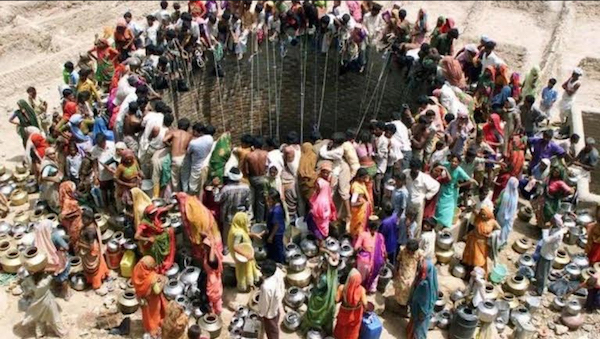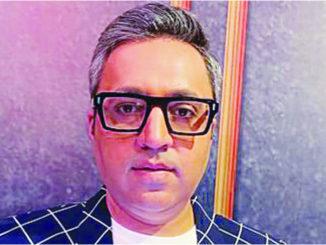

Photo:-Jay Mandal/On Assignment
“Water is essential to life, yet 844 million people in the world – 1 in 9 – lack access to it. According to a report by the World Economic Forum, the water crisis is the #4 global risk in terms of impact to society.
Access to safe water can protect and save lives, just because it’s there. Access to safe water has the power to turn time spent into time saved, when it’s close and not hours away. Access to safe water can turn problems into potential: unlocking education, economic prosperity, and improved health.
In India, “Six times the population of the United States lives without a household water connection. These people, in particular women and children, must spend time to get water, instead of working or going to school or caring for their families”. (Water.org)
The author is sanguine that the creation of ministry of Jal Shakti by Prime Minister Narendra Modi will address the problem of inadequate access to safe water, removing the “extreme water stress felt by 600 million people in India”.- Editor
The biggest disruptor in the new government of Prime Minister Narendra Modi for India is by far the creation of a ministry of Jal Shakti. The merger of the ministries of water resources, river development, Ganga rejuvenation, and drinking water and sanitation brings about a much-needed integrated approach for India’s water issues. Water will be the limiting factor to India’s growth. According to a 2018 NITI Aayog report, 600 million Indians face high to extreme water stress and about 200,000 people die every year because of inadequate access to safe water. By 2030, the country’s water demand is projected to be twice the available supply, implying severe water scarcity for millions and an eventual 6% loss in the country’s gross domestic product (GDP). However, if the Jal Shakti ministry, the one ministry on which the future depends, achieves its objectives, all that will change.
Addressing an election rally before the 2019 Lok Sabha polls, Prime Minister Modi said, “After constructing toilets and giving dignity to women, I will focus my next term on ensuring clean drinking water.” The creation of the Jal Shakti ministry and the adoption of an integrated approach to water issues formed part of the Bharatiya Janata Party’s vision. Gajendra Singh Shekhawat, the minister of Jal Shakti, has hit the ground running, adopting an inclusive approach by spelling out his vision of partnership with states. In his interview with India Today on 8 June, Shekhawat saw India’s water challenge as an opportunity to involve stakeholders. He is keen on the use of India’s traditional water conservation knowledge whose neglect has brought us to the precipice of a water disaster. He also promised “nirmal” or clean Ganga in two years.
“Nal se Jal” (tap water) for everyone by 2024 is a delayed yet essential goal for India to break into the middle-income league and become a global economic power. It is not difficult to imagine how much economic activity this goal-setting will engender, potentially contributing billions to India’s GDP through the construction/rehabilitation of reservoirs, their linking, the laying of pipes and construction of tanks, among other civil works. Its impact on the nation’s health will also be transcendental, as most diseases in India are water-borne. Nal se Jal is also a natural companion of Swachh Bharat and the National Toilet Mission, which cannot be sustained without water availability in every household. The National Democratic Alliance government has achieved ambitious goals before, be it the 72 million Ujjwala connections, taking electricity to every village and 20 million households, constructing 92 million toilets in less than five years, and the opening of more than 300 million Jan Dhan accounts. Making piped water reach every household is daunting, but the ability to achieve it is there. It is absolutely “Mumkin hai” (possible). If not now, when?
Only 4% of the available water in India is used for drinking, whereas 80% is used for irrigation with rampant inefficiencies. About 4,000 liters of water is used in Punjab to produce 1 kg of rice, though 300 liters is sufficient. The first charge of India’s water must go to drinking water, followed by crop and then industrial production. Furthermore, placing water on top of the conservation pyramid automatically leads to conservation of soil and forests, and forests make water. The mantra of water conservation is age-old and simple: hold it where it falls, in pits, wells, trenches, reservoirs or ponds. This prevents run-off and soil erosion, recharges aquifers and replenishes sub-soil moisture, critical for plant growth and survival. I speak from my experience in the early 1990s when I spent five years of my youth in rural India espousing soil and water conservation.
Living in New York, I marvel at the city’s water supply system, which provides the world’s best potable water. Even restaurants serve tap water. The city has a network of conservation watersheds, reservoirs and aqueducts with almost 95% water supplied by gravity, conserving energy. Institutional frameworks exist for every aspect, be it conservation of the watershed, reservoirs, distribution and pricing. Watershed conservation is the central principle for providing drinking water. Even corporate water bottlers such as Poland advertise the watersheds they protect to promote their products. It is not a pipedream to expect such a reality in India.
Many states have already undertaken path-breaking work. Telangana’s Bhagiratha project is worth emulating across India. Maharashtra’s Jalyukt Shivar Abhiyan has undertaken water conservation work in 16,522 villages. Unfortunately, rainfall has been poor this year, so the impact of the work is not felt. However, this is bound to change in the coming years when real water harvesting kicks in.
There is also a great synergy between bringing water to all households and the socio-cultural-spiritual movements gaining ground in India around saving the rivers, spearheaded by people such as waterman Rajinder Singh and Jaggi Vasudev. As Vasudev recently said, “Jal Shakti is a landmark step for revitalization and conservation of our rivers and water bodies.” They are opinion makers and have far reaching influence on people. The merger of their objectives with national priorities augurs well for India. On the lines of the International Solar Alliance that India pioneered, we may lead the world on water conservation from Jal Shakti to Bharat Shakti to Vishwa Shakti.
(The author is an Indian career diplomat, presently posted as Consul General of India in New York. He can be reached at cg.newyork@mea.gov.in)
This article originally appeared in Live Mint and has been reprinted, with some additions, with the permission of the author.





Be the first to comment